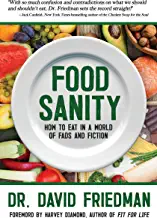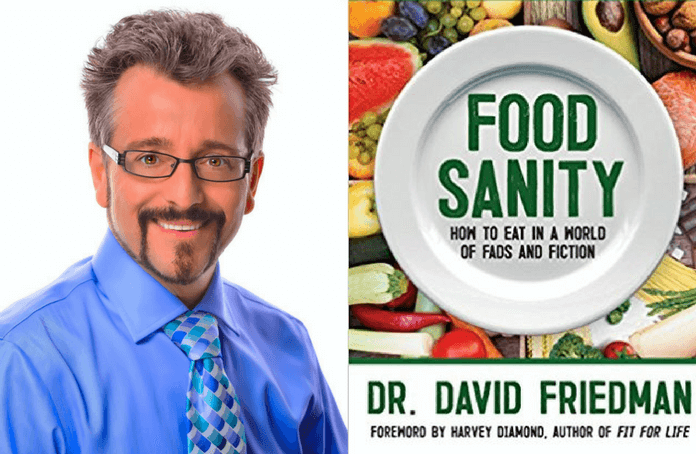Food Sanity by Dr. David Friedman
Every year, a new diet trend guaranteed to help us live healthier lifestyles an shed some pounds emerges. But even with all the diets out there, a lot of the time they are replications of the tried and true methods we know: counting calories and exercising. Some focus on carb-loading, others on protein, and most just completely contradict what we think we know. With all the advertisements, celebrity endorsements and more, it can be enough to drive one insane! This is where Dr. David Friedman comes in— his goal is to help us sort through all the craziness and live longer, healthier, food-positive lives.
Dr. Friedman’s book, Food Sanity: How to Eat in a World of Fads and Fiction, sheds a light on different diet suggestions and methods, what foods you should be cutting out, and encourages you to take a holistic look at your health. Here, he talks to BookTrib about the confusion, contradictions and noise behind diets.
BookTrib: There’s a lot of different advice out there on what kind of diet is actually best for us to eat – and they all seem to contradict each other. What have you found is the overall best kind of diet?
Dr. David Friedman: One of the most common questions I get asked is which weight loss diet works? My answer surprises most people, “they ALL work!” Whether it’s Atkins, eating for your blood type, paleo, zone, keto, nutrisystem, or weight watchers, if you follow the program, you will experience weight loss. Unfortunately, the results are usually just temporary. One of the main reasons why so many different diets initially work is because they all have one thing in common—they change a person’s routine. They all promote eating different foods, different ways at different times. Whether it’s eating grapefruits, or steak three times a day, changing your portion sizes, or going vegan; when you mix up your daily routine, you will alter your metabolism, change your blood glucose levels, which in turn, can lead to weight loss. The challenge is keeping it off.
If you’ve tried one of the many hundreds of weight-loss plans or followed a fad diet, you know this to be true. You lost the most weight in the first thirty days, continued to lose weight in month two, and only lost a minimal amount of weight after day ninety. By the fourth month, you reached a plateau and became frustrated, which made you walk away from the diet you were on that “was” working. So here you are back to square one surrounded by a multibillion-dollar weight loss industry that just isn’t working! What now? Continue buying tickets to ride a merry-go-round of fad diets? The word “diet” comes from the Greek word ‘diaitia,’ which means “way of living.” The reason most people achieve such poor results when trying to lose weight is because they are not addressing the true meaning of the word diet. Changing your routine leads to initial weight loss, but changing your way of living is what brings permanent weight loss.
Permanent weight loss can be achieved by doing three things: Eating healthy, avoiding obesogens (chemicals that cause weight gain) and getting deep restorative sleep. Think of these three pillars as your get healthy and permanent weight loss tricycle. Your eating habits are just one wheel. You can’t accelerate and successfully move forward without the other two.
BookTrib: What do you think the most common misconception is when it comes to food and dieting?
DF: One of the biggest misconceptions when it comes to dieting is calorie counting. Fad diets come and go, but the most popular diet of the last century is calorie counting. It’s become the standard methodology for people wanting to lose weight. The problem with a calorie counting diet is that it can put your body into a “famine” mode that causes you to gain back your original weight and sometimes even more. This is why calorie counting diets are often referred to as “yo-yo diets.” By definition, a calorie is a measurement of heat. It’s the amount of heat required to raise the temperature of one kilogram of water through one degree Celsius. A calorie is heat! If heat caused weight gain, everyone living at the southern hemisphere would be obese. But actually they’re leaner.
The biggest calorie-counting organization in the world is called Weight Watchers. They’ve been having people count calories for more than fifty years! Interestingly in 2011, David Kirshaw, CEO of Weight Watchers, said in a Time magazine interview, “Calorie counting has become unhelpful. When we have a 100-calorie apple in one hand and a 100-calorie pack of cookies in the other, to view them as being ‘the same’ makes no sense.” For Weight Watchers to make a statement like that really puts into perspective the lack of success calorie counting has when it comes to losing weight and keeping it off. Calorie counting diets simply do not work! It also means having to become a mathematician, and that takes the enjoyment out of eating.
Don’t count calories, make your calories count! If you eat the right wholesome foods, you’ll never have to take out a calculator to figure out what to eat.
BookTrib: For those of us with allergies to certain foods, especially foods like fruits and vegetables, what do you think is the best way to navigate the grocery store and still have a wholesome diet?
DF: Food allergies only effect 3.6% of the U.S population yet 38% believe they are allergic to food. Many of these people don’t actually have an allergy but a food intolerance. A food intolerance can cause some of the same signs and symptoms as a food allergy, so people often confuse the two. A true food allergy causes an immune reaction that affects numerous organs in the body. In some cases, an allergic food reaction can be severe or life-threatening. In contrast, food intolerance symptoms are less serious and often limited to digestive problems. These are reversible. The key is focusing on improving digestion and removing the factors that have created the intestinal immune response to certain foods.
Food intolerance is often due to chemicals people are exposed to which can wreak havoc on the intestinal flora and its ability to digest and assimilate certain foods. These chemicals, called “obesogens,” can come from antibiotics (often from animals we consume,) hormones, dyes, artificial sweeteners and preservatives. Sometimes the containers that store your food are to blame. Many are made out of plastics that contain Bisphenol-A (BPA), a synthetic estrogen primarily used to harden plastics. These can leach into your food and have a negative effect on the immune system, increase insulin resistance, cause weight gain and may even contribute to the cause of cancer!
In Food Sanity I share how to navigate through the grocery store and eliminate obesegens. By doing this, you will improve digestion and can then slowly re-introduce foods back into your system that you were once sensitive too.
BookTrib: What is the biggest one change we can make that will overall effect our health for the better?
DF: Get off dairy! Despite decades of government and industry propaganda about the health benefits of dairy products, unbiased science proves that cow’s milk is not healthy for humans. We are taught as children if we want to grow up big and strong we need to drink milk. Yet children that drink milk get more chronic ear infections, have more allergies, are more likely to be overweight, and are at greater risk of diabetes.
The primary reason why cow’s milk is so unhealthy is a protein it contains called casein. Casein from cow’s milk is also used to make glue to hold together wood (think of the cow logo on Elmer’s Glue) and a polymer used to make plastics. If you were to swallow glue, your body would consider this an invasion and attack it. When you ingest casein, a glue like substance in milk, your body attacks it by producing histamines, which causes mucus production that can lead to bronchitis, allergies, asthma, sinus and ear infections, irritable bowel syndrome, and diarrhea, just to name a few. Numerous studies, including data from the World Health Organization (WHO), have also linked consumption of casein with increased risk of heart disease, high cholesterol, and diabetes!
Casein is what makes a 100-pound baby calf grow into a 2,000-pound cow. The average human baby weighs less than 8 pounds and grows into a 170-pound adult. Here’s a common-sense question for you: Would you use rocket fuel in the gas tank of your moped? Of course not! Why would you put gargantuan-size cow fuel inside a human body? For the calcium, you say? That’s another misnomer. Contrary to all those milk mustache ads, milk doesn’t build strong bones. In fact, research shows milk may be a contributing factor to the cause of brittle bones. Milk is pasteurized, meaning it’s been exposed to extreme heat. This heat process is required to destroy bacteria but it also renders a lot of the calcium it contains insoluble. Most of the usable calcium in cow’s milk is destroyed during the manufacturing process.
What if raw unpasteurized milk was available? It still wouldn’t give you enough magnesium needed for your body to absorb it. The calcium to magnesium ratio in cow’s milk is 9 to 1 (90 percent calcium/10 percent magnesium). Most experts recommend having a ratio of two parts calcium to one part magnesium and some studies show a 1 to 1 ratio is better. When you look at plants, we can attain the perfect balanced ratio of calcium and magnesium. Sources like almonds, squash, sesame seeds, and spinach offer almost a perfect 1 to 1 ratio of calcium to magnesium. These ratios allow the two bone-building partners calcium and magnesium to do their job. Cow’s milk is not needed in the diet and offers a lousy source of calcium.
Food Sanity: How to Eat in a World of Fads and Fiction will be available for purchase on February 20th. For more information on the author, please visit his website at doctordavidfriedman.com
Buy this Book!
Amazon




